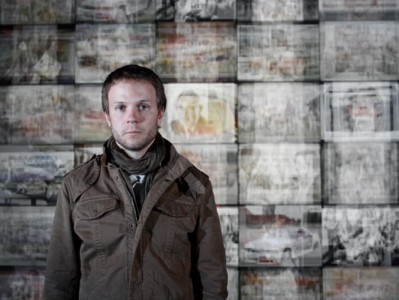By Dana Lacey
Uncompromising and raw, Photog uses new media to give a glimpse into the world of conflict photojournalism.
The first rule of conflict photography: never let your boss know you’re anything but “normal.” The second rule: don’t get killed.
Photog is a new-media mash-up of true stories from conflict photojournalists, quoted verbatim but told as first-person events by the fictional Thomas Smith, played by writer/performer Jay Dodge.
The project began in Brooklyn, 2008, when theatre company Boca del Lupo interviewed a number of conflict photographers about the nature of their experiences trying to reconcile the worlds they photograph with the worlds they live in. In a series of raw and revealing revelations, photos and videos, they talk about privilege, about feeling disconnected from the world, about following the sound of gunfire instead of running from it. It was commissioned as part of the Harbourfront Centre’s Fresh Ground program.
“Pictures are like maps – they’re a way to classify the world,” Smith explains onstage as he wanders around his small, New York City apartment. “You can encapsulate an experience in an image.” He’s just returned from Iraq to face an eviction notice, seems condo developers have bought his rundown apartment building. He doesn’t have much: a chair, a few piles of books and clothing, his camera gear, his war gear, and, of course, photographs. Using physical theatre, computer animation, video and startlingly beautiful photos, Dodge talks straight to the audience, the only actor onstage for 85 minutes as he remembers the various sticky situations he’s been in – kidnapped on the Ivorian Coast, shot with mortars in Liberia, the sound of bullets narrowly missing his head in Iraq, sitting down at the end of the day in Darfur, exhausted, and realizing his bench is actually a pile of dead bodies…and not bothering to move.
After all he’s been through he’s stuck in hypervigilance mode, this unnerving, unending “terrible sense of impending doom” that alternately sends adrenaline coursing though his veins and has him breaking down in grocery store lineups (“emotional ambush”, as he calls it, is often triggered by unexpectedly banal events).
There’s a particularly telling Skype conversation with an editor in New York demanding photos for the day. “The newspaper will publish one photo from Iraq. One photo that is supposed to describe everything that happened yesterday in the entire country,” Dodge explains. He tells his boss that today’s photo should be from a car bombing that killed 200 people, except he’s nowhere near the city, so the editor tells him, send what you have. So the bombing story is never told. There’s a sense that, if no one is there to capture it, terrible events don’t exist. Certainly not in the cushy, air-conditioned West. What follows is a sense of desperation – if I don’t cover what I’m seeing, no one will. War is easily forgotten unless you’re constantly confronted with images, he says. That’s why these photographers risk life and limb, all for a bunch of pixels they hope will tell a story.
What I loved most about the play was, not surprisingly, the photography. You can’t help but feel insignificant when you see how close to chaos he gets. Wall-sized photos flash behind Dodge as he describes the moments he’s captured, the people he’s met (some photographers don’t talk to people at all, he says, but he always does). There’s a photo of an execution that was never published. There’s a photo, revealed bit by bit as he shines a flashlight across it, that’s just hundreds of skinny dead bodies, dumped on top of each other.
He shows a particularly disturbing video he took moments after a roadside bomb killed two of the soldiers he was travelling with: gripping raw footage of soldiers breaking down, crying at the loss of their comrades, as the action continues around them. Suspended from wires in the ceiling, Dodge is blown through the air when an RPG kills two men just an arms-length away (later we’ll see the wires help him reenact his stint on a runaway horse).
Carrying a camera onstage, the wall behind him displays video from Sudan, where he sees a group of young, barefooted soldiers beating a young medic – for just a frame, you see his hand reach out to the victim: a moment of humanity. He puts his camera down, pleads with the soldiers not to kill the medic. Instead, they drag the man off and he never sees him again. Holding the camera to his face as a filter is the only way he can absorb what’s around him – when he lowers the camera, even for a moment, he is paralyzed by fear.
“When I’m home, I try to act normal,” he tells the audience. He undoubtedly suffers from post traumatic stress (“I have nightmares basically all the time”), but he won’t tell anyone – not his friends, not his family, and certainly not his bosses. He knows that the newspaper won’t send him back if they think he’s “cracking”, and Dodge can’t afford not to go back: he lives assignment to assignment.
Details:
Photo of Jay Dodge by Sherry J. Yoon
Photog runs November 17-20 at the Harbourfront Centre Enwave Theatre (231 Queens Quay West, Toronto).
Tickets are available online or at the box office.
Shows start at 8 p.m.

